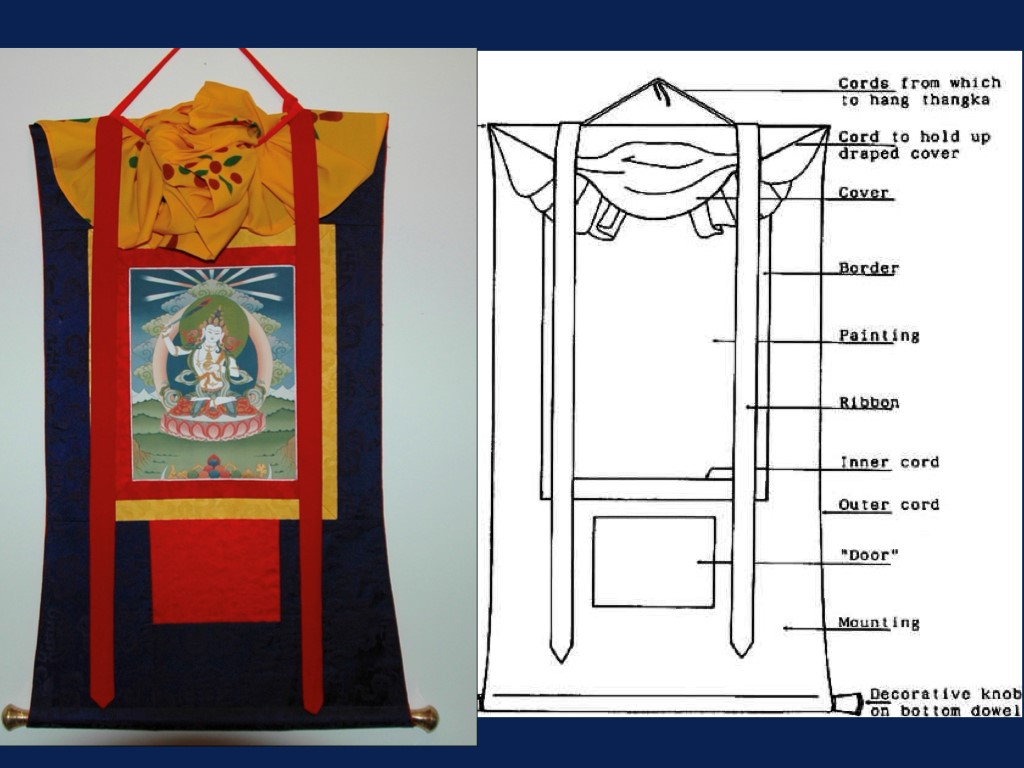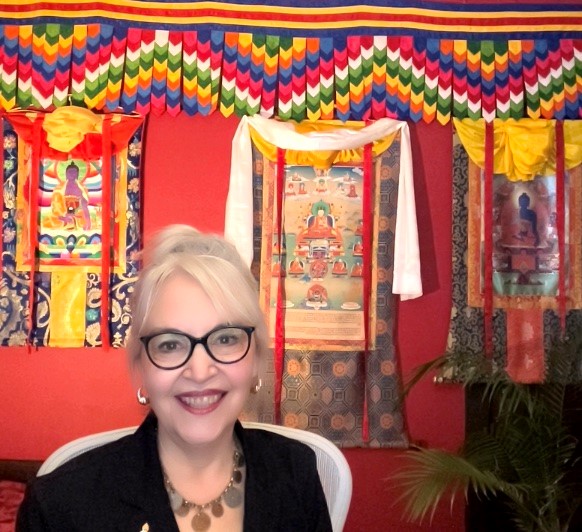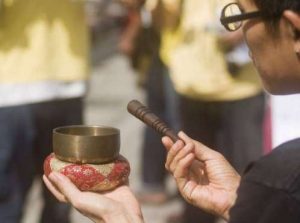Over the years, conservation as a hands-on discipline has changed with the increased usage of sophisticated analytical instruments, and with routine use of digital toolboxes. The dramatic display of “before” and “after” images of a painting being cleaned and, in some cases, repainted, is now being reconsidered the ideal goal and objective. We now have greater respect for culturally and spiritually sensitive art forms that carry evidence of a historical continuity of usage.
This is profoundly true for thangkas, which in their own traditions were never subjected to severe cleaning and repainting; such recent techniques were developed for European oil paintings and Asian scrolls on paper or fine silk. For this reason, digital restoration offers a safe path toward the respectful appreciation and analysis of iconography and style for thangka paintings, textiles, and texts of religious and historical significance. Traditionally, monastery care of thangkas was only intended to keep them in working condition as sacred art forms in daily use. Although thangka textile mountings were sometimes replaced during this history of traditional usage, only minor repairs were otherwise enacted.
When people think of Buddhist art today, they often think of thangkas prominently displayed in museums and considered collectable on the international art market. Thangka conservation is as complicated as the thangka form itself: a complex composite art form spanning centuries and continents, and still evolving.
A traditional thangka is a three-dimensional construction that includes a central iconographic panel (painted or textile), within a textile mounting. A traditional textile mounting may contain a front section and possibly includes a back lining, leather or metal corners, pendant ribbons, a textile cover, a cord to hold up the raised cover, a cord or ribbons from which to hang the thangka, top and bottom wooden dowels, and decorative finials on the lower dowel.
The thangka form evolved from the long history of scroll paintings, and especially from the nomadic lifestyle of early Buddhist monasteries. Monastics traveled extensively to outlying areas to spread the teachings of the Buddha. Everything they needed and used traveled on the backs of ponies and yaks, including texts, thangkas, robes, tents, furniture, and cookware. Consequently, thangkas were vulnerable to damaged, then as now, by rolling and unrolling, packing, and exposure to natural elements: vulnerable to both human actions and the forces of nature.
Within monasteries, thangkas were hung above shrines and often damaged by direct contact with the walls behind them and leaking roofs. The burning of butter lamps and incense offerings, traditional in Buddhist worship, created a darkening soot and grease that permeated the thangkas deeply. During ceremonies, offerings were and still are flicked toward the thangkas, creating visible accretions and spotting from blessed substances.
The modern thangka form is changing due to the availability of materials and new techniques. For example, yak hide glue, once carefully refined for thangka paintings and true “earth colors,” are no longer readily available. Meanwhile, strong demand in tourist and international art markets has contributed to a rise in thefts from monasteries, and the creation and sale of fakes and forgeries is on the rise.
The purpose of thangkas and their relationship to sacred texts
Thangkas illustrate iconographic depictions from sacred texts, serving as a guide to meditation and visualization. The relationship between the texts and illustrative art is traditional and ongoing, even in today’s digital universe. Many thangkas have writing on the reverse as part of the process of transforming the thangka as a physical form into one that carries the energy of the deities depicted by empowerment blessings. Some thangkas bear extensive writing on the front and back for the names of the deities and/or the scenes illustrated, and for more extensive quotations of texts and extended blessings.
The world of traditional Buddhist monastery archives and the changing art forms that continue to illustrate sacred texts is still visible. Although traditional texts are created from differing methods and materials, according to geography and style, they are all open to certain categories of damage. Texts are found to be stained and darkened from oil on the fingers turning the pages, butter-lamp smoke, and incense grit mixture used as respectful offerings. The pages are also vulnerable to fraying and to insect damage.
The copying tradition
Copying texts is firmly within the tradition. Traditional block printing and hand copying of historic texts created continuity. More recently, texts are being digitized to preserve the information they contain and for wider distribution.
Traditionally, when a thangka became too weakened or darkened through traditional usage, a thangka painter was hired to create a new one, often copying the original. The new thangka then continued to serve its purpose as a guide to meditation and visualization. The historic blessed thangka was then continued in use, or was retired with respect, placed in the room of a teacher or even offered within a stupa.
Dangers of over-cleaning
Within the past few decades, however, art dealers, collectors, museums, and even some temples are over-cleaning and actually repainting historic thangkas. Reasons for this could be a wish to reveal iconography hidden beneath years of darkening, or to increase the potential financial value for resale.
Cleaning a thangka painting rarely works and is often permanently damaging. Unlike European oil paintings, for which specific conservation cleaning techniques were developed, historic thangkas have no varnish layer. Furthermore, Asian aqueous cleaning techniques designed for thin paper or silk supports are shown to damage the traditional hide glue used in thangka ground and paint layers.
Permeating grease and grit darkening cannot be removed without permanently damaging the blessed historic thangka painting. Cleaning and then repainting a thangka to make it look newer is never successful and also creates permanent damage. Anyone who wants a new-looking thangka can hire a thangka painter to create a new thangka. The original thangka can be preserved with safe storage, handling, and competent display.
The historical evidence of use and blessings can be respected and preserved in thangkas. A traditional and respectful approach is:
• Minimal conservation to stabilize structural damage where necessary on historic thangkas.
• Creating a new thangka by copying the old one.
Safe digital restoration
If a blessed, historic thangka painting is deeply darkened by permeating layers of butter lamp grease and incense grit, or structurally damaged from rolling and unrolling by a network of creases, folds, and tears in the support (resulting in loss in the ground and paint layers), the original iconography may be obscured.
Buddhist iconography can be extremely complicated due to the teachings from different lineages, revealed teachings from meditation masters, and the vast number of texts. The iconography details of Buddhist deities are also vast. No scholar, meditation teacher, or thangka artist would claim to know every aspect of Buddhist iconography. Therefore, it would be ideal to have access to the original iconography from a darkened and damaged thangka, without damaging the blessed original.
I have recently been looking into the use of digital restoration for this purpose, to reveal original iconography for the creation of new and accurate thangkas, for both scholarship and for the continuity of the Buddhist teachings. This technique is called “digital inpainting.”
For this project, I chose a historic, unrestored thangka from the Treasure Caretaker Training study collection. Our study collection of thangkas, textiles, texts, statues, and so on, is available for scientific research and hands-on conservation workshops. The thangka for our case study, depicting Amitabha in the Pure Land, originates from central Tibet and is dated to the late 18th century. The traditional thangka consists of the painting set into its original textile mounting. The textile mounting has a dark blue silk front, top and bottom “doors” of decorative silk brocade with metal-on-paper supplementary wefts, and a back lining. The top and bottom wooden dowels and silk cover are not present.
This thangka has been a subject of scientific analysis in a 2008 project titled Thangka Production in the 18th–21st Centuries: Documenting the Introduction of Non-Traditional Materials into Himalayan Painting Practice. The project was co-authored by Jennifer Mass, Jo-Fan Huang, Betty Fiske, Ann Shaftel, Xian Zhang, Richard Laursen, Courtney Shimoda, Catherine Matsen, and Christina Bisulca.
Skillful and inexpensive use of specific frequencies and the placement of light sources during documentation photography, and the use of post-capture applications, helped to identify indistinct details and condition concerns.
Traditional thangka paintings made with hand-ground “mountain color” mineral pigments are three dimensional, with a surface like a field of jewels. Traditional rolling and unrolling, as well as storage in a trunk of other rolled thangkas crushing each other, can result in damage and loss to layers of detail in damaged paint layers of diverse particle sizes.
Through the science of light, we can make visible elements of written text and painted iconography that have been damaged, but without harming the originals. Simple placement of light source, such as transmitted light and raking light, and the use of inexpensive post-capture applications are techniques that are easily used in most monastery settings. The use of post-capture applications such as the inexpensive iDStretch, can reveal details not visible to the eye by applying diverse light sources to a digital image and not to the original thangka.
For a more comprehensive digital restoration, I requested Thomas Yeshe Dalarud to recreate the original painting as it might have looked in the late 18th century. Dalarud, who strives to reveal both the hand of the master painter and the original iconography, created a series of digital images to show how the historic thangka most likely appeared when it was originally created.
Working with the original painting, Dalarud created a high-definition digital image. From that, he made a series of images that slowly revealed the information contained in the original iconography. Dalarud reported that the repair-stage of all cracks, watermarks, and so on, was the process that took the longest time for this thangka, taking roughly 85 per cent of the total 120 work hours to complete. He was also able to map the iconography after digitally revealing the details. Following are the steps in this process in Dalarud’s own words, with each step in successive images below:
• Photograph original thangka to create high-resolution digital image;
• Reduce major folds and unevenness using software;
• Rediscover original colors, details, and contrasts;
• Further improvement of colors, details, and contrasts in highly damaged upper area of the thangka;
• Repair all damaged areas;
• Complete restoration of Amitabha Buddha in the middle.
From his years of experience, Dalarud has created a final image that he feels is closest to how the painting looked when it was first created. The intermediary images still contain visible remnants of physical damage through darkening and the loss of the ground and paint layers.
Some viewers advocate a complete digital reversal of extant damage, which obscures the artist’s original intent to illustrate a specific iconography. Some prefer that the iconography is revealed with evidence of damage remaining, while others prefer to learn how the original may have looked, the fresh mineral colors as well as details of form and placement. At what point does the recreation serve its purpose to provide a guide for meditation?
Thangkas in traditional form can be recreated with any of the sequence of images printed on fabric, and then sewn into a traditional thangka textile mounting. Thangkas with printed iconographic panels are already popular and used in monasteries. A digitally restored painting can also be shared as a digital file for use in meditation by Buddhist practitioners, and distributed at low cost to monasteries worldwide.
The potential for this approach is significant: it complements with the basic Buddhist teaching of impermanence, while making it possible to recreate the historical iconography illustrated by thangka masters without permanently damaging the original thangka. At the end of the day, digital inpainting respects the traditional use of a sacred art form and the purpose and continuity of its iconography.
About the author
Ann Shaftel ([email protected]) is a Fellow of the International Institute for Conservation and the American Institute for Conservation, and is a member of the Canadian Association of Professional Conservators, ICOM, and ICOMOS. Since 1970, Ann has worked in the conservation of Buddhist art with monasteries, Dharma centers, museums, universities, and communities. Her work is referenced by international scholars and advised and blessed by Buddhist teachers.
Established in 1970, Treasure Caretaker Training is a non-profit organization dedicated to working closely with nuns and monks for the preservation of Buddhist treasures in monasteries and communities. The Preservation of Buddhist Treasures Resource, is a free online reference of practical information on digital documentation, risk assessment, disaster planning, and recovery, and safe storage techniques for the preservation of thangkas and other sacred treasures. It is written in direct response to questions asked by monastics and illustrated with images from their monasteries. Preservation workshops in India, Nepal, and Bhutan are continuing in 2022.
About the artist
Thomas Yeshe Dalarud ([email protected]) is an artist living in Sweden. He has degrees in fine art painting and graphic design. He has lived in India, Tibet, and Nepal studying Buddhism and the art of thangka painting. Dalarud apprenticed with the well-known and celebrated thangka painter Gega Lama and is knowledgeable in Buddhist iconography.
As a visual artist, graphic designer, and photographer, Dalarud works in the digital domain while maintaining traditional artistic skills. He has developed techniques to digitally restore damaged thangkas and his rare combination of skills is vital for this work.
See more
Risk Assessment for Monasteries and Communities, a presentation for Buddhistdoor Global (YouTube)
Traditional Sacred Buddhist Texts and the Art that Makes them Accessible. A public lecture with Dalhousie University School of Information Management (YouTube)



























Brilliant work and explanation/exposition by both. Ann is a blessing to the conservation of this tradition. This article was particularly revealing in both what can be done and what should not be done in the process.
Agreed, very well done!
The use of digital tools for conservation, as well as the clear concise writing in this article are both expeirnced as very Skillful Means. Rejoicing in this important work.
Amazing article!! Thank you for the work you are doing.
I am looking for decorative metal dowel ends for one of my thangkas. Do you know of any sources?
Thanks,
David